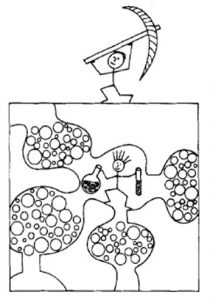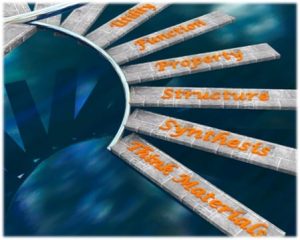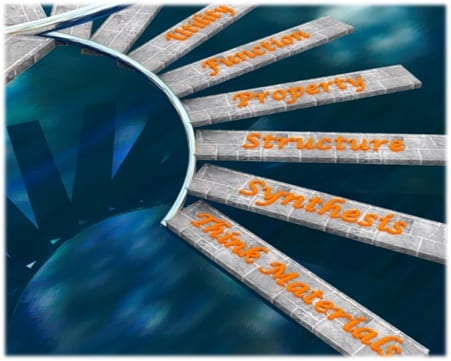(Ed: Happy Birthday Professor Ozin!)
It is the 20 year anniversary of the 1992 Advanced Materials paper “Nanochemistry – Synthesis in Diminishing Dimensions”. I thought it would be an interesting exercise to see how the promising future I imagined for this fledgling field back then is working out in practice today. Pertinent to my thoughts on this matter is my opening statement in the paper and a graphical comparison of the top-down nanophysics and bottom-up nanochemistry philosophy’s of making nanomaterials:
 “Nanochemistry, as opposed to nanophysics, is an emerging sub-discipline of solid-state chemistry that emphasizes the synthesis rather than the engineering aspects of preparing little pieces of matter with nanometer sizes in one, two or three dimensions. Currently there is considerable interest in nanoscale objects, since they exhibit novel material properties, largely as a consequence of their finite small size. The nanochemist can be considered to work towards this goal from the atom “up”, whereas the nanophysicist tends to operate from the bulk “down”. Building and organizing nanoscale objects under mild and controlled conditions “one atom at a time” instead of “manipulating” the bulk should in principle provide a reproducible method of producing materials that are perfect in size and shape down to the atoms. A cartoon of this comparison is shown in the illustration. These little objects can be made of organic, inorganic and/or organometallic components. Their structure-property relationships are designed to yield new materials with novel electronic, optical, magnetic, transport, photochemical and electrochemical, catalytic and mechanical behavior. Areas of application that can be foreseen to benefit from the small size and organization of nanoscale objects include quantum electronics, nonlinear optics, photonics, chemoselective sensing, and information storage and processing”.
“Nanochemistry, as opposed to nanophysics, is an emerging sub-discipline of solid-state chemistry that emphasizes the synthesis rather than the engineering aspects of preparing little pieces of matter with nanometer sizes in one, two or three dimensions. Currently there is considerable interest in nanoscale objects, since they exhibit novel material properties, largely as a consequence of their finite small size. The nanochemist can be considered to work towards this goal from the atom “up”, whereas the nanophysicist tends to operate from the bulk “down”. Building and organizing nanoscale objects under mild and controlled conditions “one atom at a time” instead of “manipulating” the bulk should in principle provide a reproducible method of producing materials that are perfect in size and shape down to the atoms. A cartoon of this comparison is shown in the illustration. These little objects can be made of organic, inorganic and/or organometallic components. Their structure-property relationships are designed to yield new materials with novel electronic, optical, magnetic, transport, photochemical and electrochemical, catalytic and mechanical behavior. Areas of application that can be foreseen to benefit from the small size and organization of nanoscale objects include quantum electronics, nonlinear optics, photonics, chemoselective sensing, and information storage and processing”.
Questions
Has nanochemistry emerged as a new field, a discipline, a branch of knowledge in its own right, has it gained mainstream acceptance as opposed to just being a sub-section of materials chemistry? Is activity in synthesizing and organizing nanoscale objects with novel size and shape tunable properties increasing? Is the accrued fundamental scientific knowledge of nanomaterials enabling applications envisioned for nanochemistry in information technology, biotechnology and nanotechnology?
Is nanochemistry a field?
Some metrics and information to help think about whether nanochemistry has achieved this status include the following: a Google search on nanochemistry returns more than 300,000 hits on a cornucopia of topics that crisscross the borders of the science, engineering, biology and medical disciplines; stunningly beautiful microscopy and graphical ‘Art/Science’ images of nanomaterials made through nanochemistry pervade the internet; nanochemistry has entered the pages of Wikipedia where it is acknowledged as a new branch of nanoscience concerned with the preparation and reactions of nanomaterials in the size range of 1-1000 nm; intensive research in nanochemistry is underway by top rank scientists in most of the world’s university, industrial and government research laboratories; nanochemistry centers, institutions and networks have been established in different corners of the globe; prestigious international prizes are being awarded to nanochemistry pioneers including the Nobel, Millenium, Bower, Albert Einstein, Kavli, Wolf, Kyoto, King Faisal, Lemelson and Feynman; new and well established scientific journals publishing nanochemistry papers have appeared and grown in number across the disciplines; undergraduate and graduate textbooks on nanochemistry are continuing to appear; nanochemistry is taught in universities around the world; billions of dollars are being invested annually to fund basic and applied research in nanochemistry on the grounds that new nanomaterials will drive new nanotechnologies; nanochemistry breakthroughs in nanoscience and nanotechnology are frequently reported in the popular press and scientific magazines; the general public is becoming aware of goods and services in their lives enabled by nanochemistry; national nanotechnology research strategies around the world have been initiated to grapple with the complex and urgent task of establishing the effects of nanomaterials prepared using nanochemistry on human health and the environment.
Based on this information I contend nanochemistry is a field and we can all look forward to ‘better living through nanochemistry’.
Is interest in the size and shape of nanomaterials made by nanochemistry increasing?
The search for the atom-perfect nanomaterial, whatever its size and shape, and growing single crystals thereof suitable for obtaining a single crystal X-ray structure continues to be a challenge for nanochemistry. This situation is improving with the growing interest in chemical and physical methods for separating and characterizing the structure and properties of nanomaterials with different size and shape, notably size selective crystallization, gradient and analytical ultracentrifugation. The composition field of nanomaterials has increased to more-or-less encompass the periodic table of materials and properties – almost every size of nanomaterial from nanometers to hundreds of nanometers is now accessible; many shapes of solid and hollow nanomaterials from cubes to spirals, wires to plates to poly-pods have been realized experimentally with impressive control of their chemical nature. Control and understanding of defects and dopants in nanomaterials is showing impressive progress, a broad spectrum of hierarchical architectures is emerging from self-assembled clusters to superlattices to chains, and a mounting library of nanocomposite architectures is arising from core-corona spheres, cubes and rods to binary heteronanostructures, a veritable ‘periodic table of nanomaterials’.
There is still much interest in nanomaterials made by nanochemistry aimed at expanding and enriching the pool of knowledge upon which future nanotechnologies will be founded.
Is nanochemistry delivering nanomaterials with interesting size and shape tunable properties?
Returning to the idea of a ‘periodic table of nanomaterials’, it is probably fair to say that there is no important bulk material chemical or physical property which has not been touched in some positive way by reducing their scale to nanometers through nanochemistry, examples being the metal-nonmetal transition, surface plasmon resonance, photoluminescence, Seebeck effect, melting point, phase change, water splitting, and hydrogen storage The driving force for the majority of work in this endeavor has been to understand how the chemical and physical properties of materials synthesized at the nanoscale change with size and how to exploit these size tunable properties in a wide range of technologies to realize the nano advantage.
 To comprehend the revolutionary impact of the ‘materials to nanomaterials’ paradigm shift, one must go to the source of how purposeful materials of the last century have been created from the chemical juxtaposition of a ‘periodic table of the elements’ and how this modus operandi metamorphosized into nanomaterials fashioned from a ‘periodic table of materials’.
To comprehend the revolutionary impact of the ‘materials to nanomaterials’ paradigm shift, one must go to the source of how purposeful materials of the last century have been created from the chemical juxtaposition of a ‘periodic table of the elements’ and how this modus operandi metamorphosized into nanomaterials fashioned from a ‘periodic table of materials’.
How did this happen? It can be traced to a universal operating principle that has guided the development of a century of materials science. This principle is expressed as synthesis to structure, structure to properties, properties to function, function to utility.This materials operating principle can be expanded and enriched through a ‘stairway’ of the six fundamental nanochemistry concepts of size, shape, surface, defects, self-assembly and the interface with the ‘ologies’, information technology, biotechnology, nanotechnology, over ‘all’ length scales, from nanoscopic to macroscopic.
Building upon these ideas, without chemical synthesis, there would be no new materials. Without structure determination, there would be no knowledge of the atomic make up and arrangement in materials. Without properties measurements, the behavior of these structural arrangements of atoms would be unknown. Without a knowledge of the properties of materials their functionality and performance would be undefined and ultimately materials utilty would not materialize until their role for different tasks is elucidated. These are the five key operating principels of solid state chemistry upon which the fields of materials chemistry and nanochemistry are founded.
Classic examples where these concepts all come together and lead to a purposeful application for a nanomaterial are graphite to graphene electronics; zinc oxide to zinc oxide nanowire piezotronics; gallium nitride to gallium nitride nanowire ultraviolet-blue laser lab-on-a-chip and high-density data storage coherent light source; silicon to silicon nanowire battery; titania to nanocrystalline titania solar cell; lead selenide to nanocrystalline lead selenide near-infrared photodetector; silver to nanocrystalline silver antibacterial; silica to nanoparticulate periodic mesoporous silica targeted drug storage delivery and release vehicle; iron oxide to nanocrystalline iron oxide cancer therapy; gold to gold nanorod tumor imaging.
This paradigm has spawned the ‘nanomaterials movement’, the driver of the 21st century nanotechnology revolution. What we are talking about in nanochemistry is controlling the physical scale of a material through chemistry, not any scale but a specific scale, one that is neither molecular or microscopic nor macroscopic matter, but a ‘fuzzy’ regime somewhere in between; an intermediate length scale, called ‘mesoscopic’. This mesoscopic scale provides a known material with new properties that through quantum mechanics can be shown to scale with its physical. Essentially, it offers a new way of thinking about creating new materials beyond variations in composition and structure from a ‘periodic table of nanomaterials,’ rather than a ‘periodic table of elements.’
Through nanochemistry a vast array of materials can be sculpted as nanomaterials with synthetic command over their size, shape, surface, defects and their self-assembly into purposeful matter. The number of possible materials combinations of the elements of the periodic table when coupled with these concepts of nanochemistry are mind boggling and one can immediately see how through nanochemistry it is possible to discover an ‘infinity of nanomaterials for an infinity of scientific investigations for an infinity of technological opportunities’, limited only by one’s imagination, providing enough inspiration to keep the materials science community busy and content for the next hundred years.
One can experience the aforementioned nano advantage, for example over a platform of materials energy systems, where they may be engineered for solar cells, fuel cells, batteries, supercapacitors, thermoelectrics, piezoelectrics and where the enhanced performance relative to their macroscopic counterparts always looks to the nano advantage. Take nanorods, nanowires, and nanotubes: they are all one dimensional nanoscale constructions and can, for example, be comprised of almost any element or element combination in the periodic table such as carbon, gold, silicon, zinc oxide, titania or gallium nitride. But they are not the materials as we know them in the bulk form. Their tiny size endows them with vastly more surface area and surface active sites with respect to their volume than our experience of normal size rods, wires and tubes. And their optical, electrical, magnetic, photonic, plasmonic and mechanical properties can be engineered to be distinct from those of their parents.
These are nanomaterial attributes that provide them with the ability to speed up the rates of chemical and photochemical processes, like the production of gasoline from oil, hydrogen from water and methanol from carbon dioxide. These are the qualities that enhance the efficiency of physical processes exemplified by better generation, storage and delivery of electricity in lithium ion batteries, fuel cells and supercapacitors. These are the characteristics that serve to increase the harvesting and conversion of light to electricity in solar cells, and enhance the transformation of mechanical and thermal energy to electricity in piezoelectric and thermoelectric devices. These are the traits that often make for brighter luminescence and more efficient light emitting diodes.
That’s the nano advantage for energy nanomaterials, a catalyst for change through the nanochemistry experience!
Is innovation in nanochemistry birthing nanotechnology?
Experience has shown over the last century that the time to nurture a breakthrough in materials research through to a product or process can be 10-20 years. Since the emergence of nanochemistry as a field there has been exponential growth of research activity in the area globally and the record shows that many Fortune 500 companies are exploring nanochemistry as an engine for innovative nanotechnologies, thousands of spin-off companies have sprung up attempting to develop, manufacture and commercialize nanochemistry based products, thousands of nanochemistry based goods have entered the consumer market place, and to allow nanotechnology to bear fruit without harm to human health and the environment, protocols are being actively formulated by government agencies to regulate the safe handling, storage and disposal of nanomaterials.
Nanochemistry has done a lot of birthing!
A Nanoscale Future
In closing it is worth noting the concluding statement of my 1992 Nanochemistry paper:
“We are entering an era of solid-state chemistry and physics in which there will be increasing demands for structured nanophase materials with stringent requirements of size, shape and dimensionality, as well as the type and concentration of dopants, defects and impurities. In such a world of tiny objects, processes and devices, the undisputed production workhorse of the nanophysicist over the next decade or so will be sophisticated forms of planar deposition and lateral engineering techniques. The practical limit of these methods appears to be about 100Å. Beyond this size, the nanotips of scanning probe microscopes will continue to be developed towards achieving the ultimate in miniaturization, namely atomic and molecular scale devices. This promising technology could show some practical utility in the 21st century provided that the huge challenge of rapidly and reproducibly moving matter at the atomic level can be surmounted. Meanwhile the elegant patterning and templating methods of the chemist for producing spatially controlled nanophase materials are likely to receive increasing attention in the exciting nanoscale world of the future.”
Clearly top-down and bottom-up approaches to nanostructured materials have burgeoned beyond my wildest expectations. A portfolio of innovative hard and soft lithography methods are pushing the spatial resolution envelope towards 10 Å for practical information technology, biotechnology and nanotechnology devices; thousands of hard and soft nanotips are pushing molecules and materials around into functional constructs at scales smaller than what would ever have been imagined possible; chemists have learned how to reconstruct almost every known material through chemistry into nanoscale versions with precision of size and shape honed towards the degree of perfection only dreamed about twenty years ago; and interest in applications of nanomaterials, touted (as well as debunked) as the trillion dollar industrial revolution has gone global, which has focused keen attention on approaches for safely and economically scaling the production of nanomaterials in different forms concurrently with the development of ‘green nanochemistry’ manufacturing methods for making ‘green nanomaterials’.

















